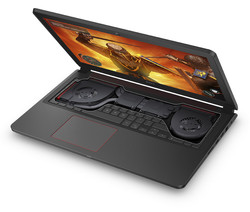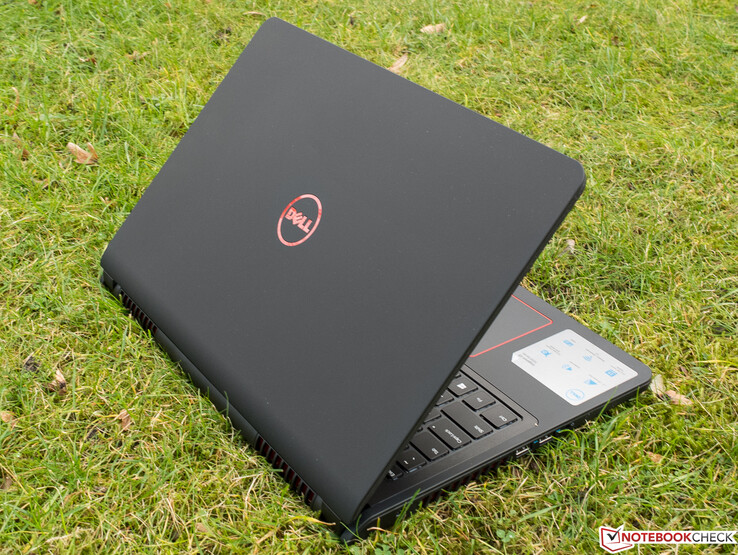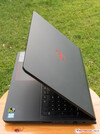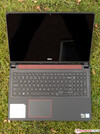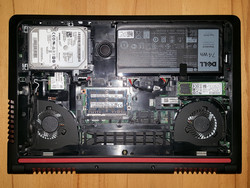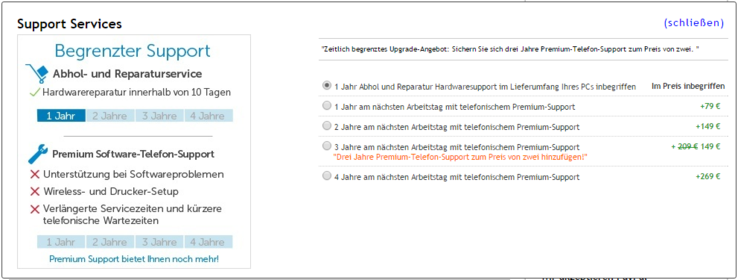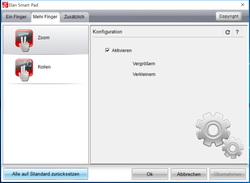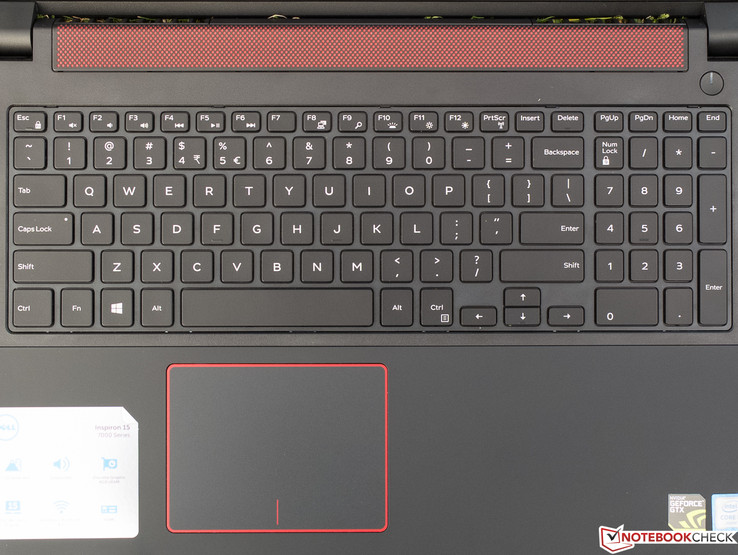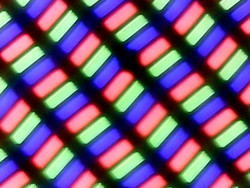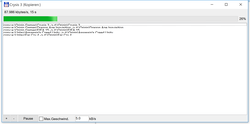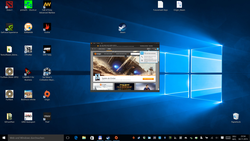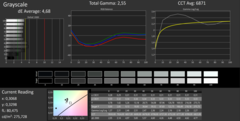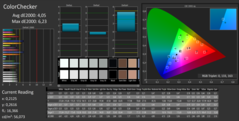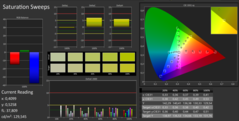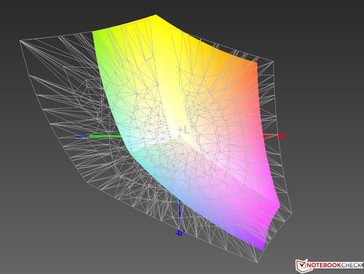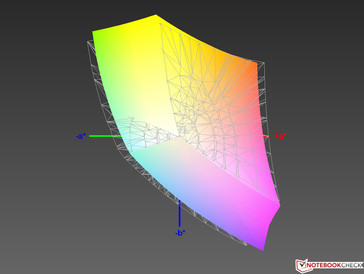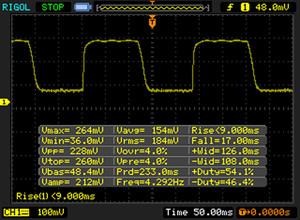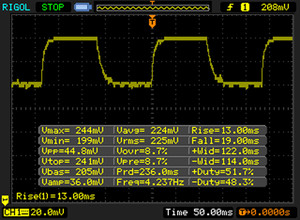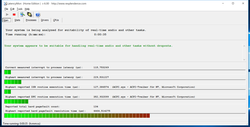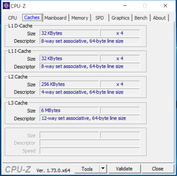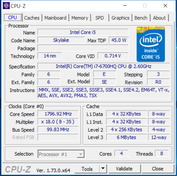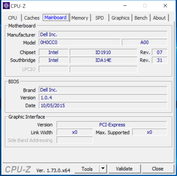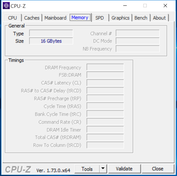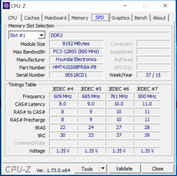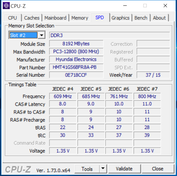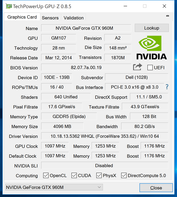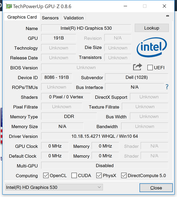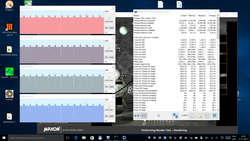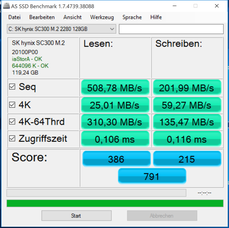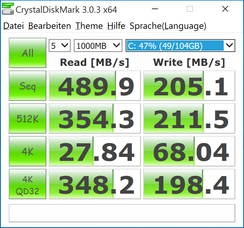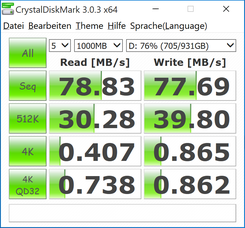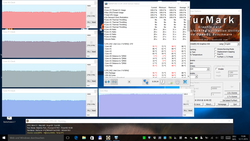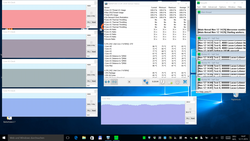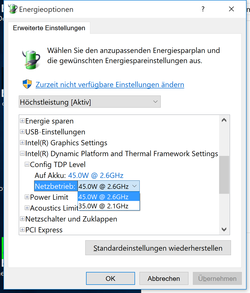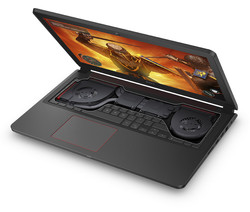Dell Inspiron 15 7559 Notebook Review

For the original German review, see here.
With a weight of almost 2.7 kg (~6 lb), the 15-inch Dell Inspiron 15 7559 is a multimedia notebook that is not particularly mobile. The most noticeable feature is the high-resolution 4K touchscreen with 3840x2160 pixels. Sufficient performance is ensured by a new Skylake processor with four native cores and Hyperthreading, Intel Core i7-6700HQ, which is supported by 16 GB of DDR3-RAM. The integrated SSD with a capacity of 128 GB is important for smooth user handling, which is complemented by a conventional hard drive with a capacity of 1 TB. The impressive package is rounded off by the performance GPU Nvidia GeForce GTX 960M, even though this will be the limiting factor in games. The lack of an optical drive is unusual for this class of devices. Our review sample from Dell was equipped with a U.S. keyboard.
The RRP for our review configuration is 1299 Euros (~$1376); at the time of this review, other versions were not listed on the website of the Dell. You can find other notebooks from the 7000 series, but they do not have a lot in common with our model. There was also some confusion because a search with a large price comparison in Berlin resulted only in a model with the designation "7602" that was equipped with a conventional Full HD display and only 8 GB of RAM.
Two of our 15.6-inch comparison devices this test, the Asus ZenBook Pro UX501JW-FI218H (no price available) and the MSI PE60-2QEi581 (around 1100 Euros/~$1060), use the same GTX 960M (2 GB) and comparable, albeit older CPUs. On the other hand, the particularly slim Acer Aspire V 15 Nitro VN7-572G-72L0 (around 1200 Euros/~$1271) is equipped with the slower GTX 950M and a frugal dual-core i7 processor with Hyperthreading. The MSI PE60 is the only notebook in this comparison that uses a conventional HDD.
Case
The design of the black plastic chassis with some red elements is obviously a matter of taste and should be appealing to male users in particular, but we liked it. Both the lid as well as the palm rest have a silky and grippy soft-touch finish, which is not very susceptible to fingerprints and can be easily cleaned. Unusual: The Dell 7559 has three carefully designed fan exhausts. Two of them are located at the back and one on the left side. Despite the absence of metal, the 15-inch device is not really light at 2.7 kg (~6 lb).
Even though the lid, which is easy to open with one hand and tends to bounce, is not really thin, you can see picture distortions at some spots when you apply pressure. As with most touchscreens, the display glass covers almost the entire display frame. It does not require a lot of force to twist the base unit and there was also some unhealthy creaking, which affected the strikingly flawless impression of the chassis. However, we did not notice any build quality issues like uneven gaps or protruding edges.
Connectivity
Since there is no optical drive, Dell could have located the ports further at the back and not at the center of the sides. At least they are not at the front, so attached cables and devices are not a huge problem. Despite the higher price, you only get the essentials as well as three USB 3.0 ports, which however should be sufficient in practice. The HDMI 1.4 output has to be used to connect to external monitors, therefore, it is only possible to use one monitor besides the internal screen. We measured transfer rates of around 100 MB/s at the USB 3.0 port with an external hard drive.
We also checked the performance of the SD-slot in combination with our reference SD-card Toshiba Exceria Pro SDXC 64 GB UHS-II. The maximum transfer rate is up to 84 MB/s when you copy large files, while you can expect up to 58 MB/s when you handle typical jpg. files (each around 5 MB).
Maintenance
Finally! One large maintenance cover at the bottom secured by only one screw and is very easy to remove, allows access to the following components: Battery, HDD; Wi-Fi module, RAM slots and SSD. What more can you want? The Inspiron 7559 is the most maintenance-friendly notebook that the author has reviewed so far. Only one thing is missing for perfection: A battery that can be removed from the outside.
Communication
As the name suggests, the features of the Wi-Fi module Intel Dual-Band Wireless-AC 3165 are actually quite clear. If the 2.4 GHz band is pretty crowded at your location, you will be happy to hear that 5 GHz networks are supported as well, even though you will obviously need a corresponding router. The standard IEEE 802.11ac (“Gigabit-WLAN”), which is not really new anymore, ensures potentially high transfer rates. Because of a defective router, the author had to change his individual test environment, so we cannot compare the results with old reviews at this time. In combination with a new Asus RT-AC51U router and an alternative firmware version, web browsing on the Dell 7559 was still smooth at a distance of two floors and through several walls in a 2.4 GHz network.
Accessories
In addition to the mandatory power adaptor, the box contains only the usual quick-start and warranty information. Recovery drives are not included, which means that you will have to rely on the recovery partition.
Warranty
We have included a screenshot for the scope of warranty and the possible warranty extensions.
Input Devices
Touchpad
The conveniently sized touchpad of the Inspiron 7559 is implemented as a ClickPad without dedicated mouse buttons. We really like the slightly roughened surface that is surrounded by a red stripe. Neither the gliding capabilities, nor the feedback give any cause for criticism. Unfortunately, the lower part of the surface was not sitting perfectly on the button mechanics, so even slight pressure often resulted in a clattering.
However, there is no criticism for the response and the precision. Even quick swipe gestures were perfectly executed, and drag-&-drop via double tap was no problem. Subjectively, the two mouse button replacements provide a well-adjusted feedback with a firm pressure point and a clearly perceptible acoustic feedback. The limited functionality is rather disappointing (see picture). The input will actually recognize only two fingers at the same time, so you can hardly use any gestures. Even in the 400 Euros (~$424) price range most notebooks offer more in this respect.
Keyboard
Dell has provided us with a review sample of the Inspiron 7559 with a U.S. keyboard layout. Large hands might have some problems with the narrow number pad. Visually, the first impression of the well-integrated keyboard is good. Unfortunately, it can be easily dented in the center, which should not happen especially when you consider the price of the notebook.
The spongy typing experience is less inspiring. You can feel the pressure point, but it could have been more defined, in combination with the soft stroke. Positive aspects of the keyboard are the subtle and even illumination, even though there is just one setting, the flat and anti-slippery keys with a clear lettering, the status LEDs for some keys as well as the very restrained noise development of the large keys.
Display
Dell has followed the trend towards higher resolutions and equipped the Inspiron 15 7559 with an IPS UHD display with a native resolution of 3840x2160 pixels. This results in a pixel density of 244 PPI on the 15.6-inch screen, which means that the pictures are very sharp and you cannot see individual pixels at a normal viewing distance of around 50 centimeters (~20 in). Even higher pixel densities are usually reserved for mobile devices, like the Samsung Galaxy S6 (5.1-inch, 2560x1440 pixels) with 576 PPI. The very glossy surface is a result of the touchscreen functionality. Dell does not offer other displays within the Inspiron 7000 series in Germany.
276 cd/m² (center) is a good, but not an excellent value for the maximum brightness. It is sufficient for all indoor scenarios and only the Acer Aspire VN7 is noticeably brighter within the comparison group. The poor black value of 0.78 cd/m², which is even too high for IPS standards, results in only a mediocre contrast ratio of 354:1. The situation is similar to the Asus ZenBook Pro, but the other two notebooks manage much higher values thanks to their better black values (~0.3 cd/m²). Subjectively, black (RGB 0, 0, 0) does not even appear very rich compared to brighter picture contents, which is quite rare. A brightness distribution of 85% is just average, but we could only notice minimal backlight bleeding at the lower edge of the panel.
There can still be massive issues due to the high resolution with some applications in Windows 10 (see pictures). The tiny font in Origin, for example, required a magnifier to be used comfortably.
| |||||||||||||||||||||||||
Brightness Distribution: 85 %
Center on Battery: 276 cd/m²
Contrast: 354:1 (Black: 0.78 cd/m²)
ΔE ColorChecker Calman: 4.05 | ∀{0.5-29.43 Ø4.78}
ΔE Greyscale Calman: 4.68 | ∀{0.09-98 Ø5}
90% sRGB (Argyll 1.6.3 3D)
58% AdobeRGB 1998 (Argyll 1.6.3 3D)
64.6% AdobeRGB 1998 (Argyll 3D)
90% sRGB (Argyll 3D)
63.4% Display P3 (Argyll 3D)
Gamma: 2.55
CCT: 6871 K
Now we are looking at color deviations, which are represented by DeltaE values. Lower values indicate a lower deviation from the ideal value and the results should be smaller than 3 for professional purposes. Only the MSI PE60 manages this ex-works, while the other comparison devices, including our review sample manage average results for IPS screens between 4 and 5, which is still sufficient for private users. The MSI display is not suitable for (semi) professional picture editing, because it covers only 64% of the wider AdobeRGB color space. However, it is the best result within the comparison and slightly ahead of our Dell. Our review unit does not suffer from a visible color cast.
| Dell Inspiron 15 7559 | Acer Aspire VN7-572G-72L0 | Asus Zenbook Pro UX501JW-FI218H | MSI PE60-2QEi581 | |
|---|---|---|---|---|
| Display | -5% | -23% | 8% | |
| Display P3 Coverage (%) | 63.4 | 63.6 0% | 47.47 -25% | 67.6 7% |
| sRGB Coverage (%) | 90 | 82 -9% | 71.5 -21% | 97 8% |
| AdobeRGB 1998 Coverage (%) | 64.6 | 59.9 -7% | 49.05 -24% | 69.8 8% |
| Response Times | -11% | -20% | ||
| Response Time Grey 50% / Grey 80% * (ms) | 32 ? | 50 ? -56% | 43.2 ? -35% | |
| Response Time Black / White * (ms) | 26 ? | 17 ? 35% | 27.2 ? -5% | |
| PWM Frequency (Hz) | ||||
| Screen | 30% | -8% | 38% | |
| Brightness middle (cd/m²) | 276 | 328 19% | 302 9% | 300 9% |
| Brightness (cd/m²) | 273 | 310 14% | 307 12% | 282 3% |
| Brightness Distribution (%) | 85 | 86 1% | 87 2% | 90 6% |
| Black Level * (cd/m²) | 0.78 | 0.33 58% | 0.79 -1% | 0.35 55% |
| Contrast (:1) | 354 | 994 181% | 382 8% | 857 142% |
| Colorchecker dE 2000 * | 4.05 | 4.74 -17% | 5.4 -33% | 1.8 56% |
| Greyscale dE 2000 * | 4.68 | 3.15 33% | 5.99 -28% | 2.18 53% |
| Gamma | 2.55 86% | 2.51 88% | 2.32 95% | 2.37 93% |
| CCT | 6871 95% | 6336 103% | 6670 97% | 6837 95% |
| Color Space (Percent of AdobeRGB 1998) (%) | 58 | 54 -7% | 45 -22% | 64 10% |
| Color Space (Percent of sRGB) (%) | 90 | 82 -9% | 71 -21% | 97 8% |
| Total Average (Program / Settings) | 5% /
17% | -17% /
-13% | 23% /
30% |
* ... smaller is better
Even on cloudy days, the use of the notebook in the outdoors can be problematic due to its very glossy screen, and the decent luminance does not really help. Nevertheless, it is possible to work when you can avoid direct reflections, for example, from bright buildings behind you.
Display Response Times
| ↔ Response Time Black to White | ||
|---|---|---|
| 26 ms ... rise ↗ and fall ↘ combined | ↗ 9 ms rise | |
| ↘ 17 ms fall | ||
| The screen shows relatively slow response rates in our tests and may be too slow for gamers. In comparison, all tested devices range from 0.1 (minimum) to 240 (maximum) ms. » 61 % of all devices are better. This means that the measured response time is worse than the average of all tested devices (20.2 ms). | ||
| ↔ Response Time 50% Grey to 80% Grey | ||
| 32 ms ... rise ↗ and fall ↘ combined | ↗ 13 ms rise | |
| ↘ 19 ms fall | ||
| The screen shows slow response rates in our tests and will be unsatisfactory for gamers. In comparison, all tested devices range from 0.165 (minimum) to 636 (maximum) ms. » 42 % of all devices are better. This means that the measured response time is similar to the average of all tested devices (31.7 ms). | ||
Screen Flickering / PWM (Pulse-Width Modulation)
| Screen flickering / PWM not detected | ||
In comparison: 53 % of all tested devices do not use PWM to dim the display. If PWM was detected, an average of 8142 (minimum: 5 - maximum: 343500) Hz was measured. | ||
If you want a perfect presentation and move around a lot in front of the display, then there is no alternative to the IPS technology. However, there are also differences in this class, which are noticeable by brightness and contrast loss from extreme angles. The display of the Dell Inspiron 15 7559 is average in this respect, but on a high level.
Performance
Thanks to the i7 quad-core processor and plenty of fast dual-channel RAM, the Dell Inspiron 15 7559 provides more than enough performance for all common scenarios including HD video editing and 3D rendering. Even heavily parallelized games that benefit from four physical cores should never be limited by the CPU. We have already mentioned that the GPU will be the limiting factor in this case. The SSD ensures a smooth handling in practice, and 128 GB is sufficient for the most important games. Media files and other games can be stored on the additional HDD.
Processor
The fast quad-core Intel Core i7-6700HQ (4x 2.6 to 3.5 GHz, Hyperthreading, TDP 45 watts) is based on Intel’s current Skylake generation. Similar to the Broadwell processor, the chip is manufactured in a 14 nm process. Thanks to several architectural improvements ("Tick"), the new CPU manages a 5 to 10% higher per-MHz performance compared to its predecessor. Skylake replaces both Haswell as well as Broadwell and has an efficiency advantage over the 22 nm Haswell chips in particular, which should result in a better Turbo utilization under load. The standard configuration of this chip has a specified TDP of 45 watts, which means that it is suitable for larger notebooks, but the TDP can optionally be reduced to 35 watts by the manufacturer (and by the user via power settings), which will obviously affect the performance.
The processor has a nominal clock of 2.6 GHz, but four active cores can reach up to 3.1 GHz (3.3 GHz for two active cores) via Turbo Boost. A very similar performance is provided by the slightly higher clocked 47-watt chip i7-4720HQ (4x 2.6 to 3.6 GHz, Hyperthreading, Haswell), which is soldered as well. The cores could not maintain the specified 3.1 GHz in our Cinebench loop (R15, multi-core) and usually executed the test at 2.8 GHz. This means that there is no throttling, although the Turbo utilization could be better.
Two out of three Cinebench tests determine the expected performance results, which are not reduced on battery power. The diagram below shows that the single-core performance of the different CPUs is very similar, while the quad-cores manage the expected lead over the dual-cores in the multi-core benchmarks.
| Cinebench R10 | |
| Rendering Multiple CPUs 32Bit (sort by value) | |
| Dell Inspiron 15 7559 | |
| Acer Aspire VN7-572G-72L0 | |
| Asus Zenbook Pro UX501JW-FI218H | |
| Rendering Single 32Bit (sort by value) | |
| Dell Inspiron 15 7559 | |
| Acer Aspire VN7-572G-72L0 | |
| Asus Zenbook Pro UX501JW-FI218H | |
| MSI PE60-2QEi581 | |
System Performance
The results in PCMark 7 and 8 are slightly confusing. Why is the PCMark 7 overall score of the less powerful Acer Aspire VN7 36% lower compared to our Dell, but 53% higher in the Productivity benchmark? Moreover, why is the similarly equipped (in terms of CPU) Asus ZenBook Pro 77% better? PCMark 8 result is no less erratic, because the least powerful device, the Acer, comes out on top. And that the MSI PE60 with its conventional hard drive is ahead of our Inspiron 15 7559 is yet another unexpected result.
Nevertheless, the subjective performance in practice left a very good impression. Windows 10 boots very quickly, applications launch immediately and even excessive multitasking is not a problem for the quad-core.
| PCMark 8 | |
| Home Score Accelerated v2 (sort by value) | |
| Dell Inspiron 15 7559 | |
| Acer Aspire VN7-572G-72L0 | |
| MSI PE60-2QEi581 | |
| Work Score Accelerated v2 (sort by value) | |
| Dell Inspiron 15 7559 | |
| Acer Aspire VN7-572G-72L0 | |
| MSI PE60-2QEi581 | |
| PCMark 7 Score | 5636 points | |
| PCMark 8 Home Score Accelerated v2 | 2907 points | |
| PCMark 8 Work Score Accelerated v2 | 3840 points | |
Help | ||
Storage Devices
Nowadays, many modern SSDs are limited to sequential read transfer rates of around 500 MB/S because of the SATA-3 interface, which is also the case for the drive in our test model. If you look at the reading performance of small random files (4K Read), which is important for the launch of the OS and applications, you can see that the Dell Inspiron 15 7559 manages a good 25 MB/s according to AS SSD. This result is close to 30 MB/s, which is what the fastest SSDs manage (Asus ZenBook Pro).
Surprising: While the Acer Aspire manages only 10 MB/s, it has a massive advantage over the other SSD based notebooks when it reads 4K files in multiple threads (4K-64 Read). CrystalDiskMark does not confirm this behavior, so it is either an error on our part, or an oddity that we cannot explain. The ZenBook Pro has a clear advantage in terms of the not so important write performance. Overall, the rather slow Lite-ON CV1-8B128 in the Acer is at the bottom of the ranking, while the SSDs in the Asus and the review unit are pretty much on par on a high level. Far behind all these devices is obviously the MSI PE60, even though the results are actually pretty good for a conventional hard drive.
GPU Performance
The familiar Nvidia GeForce GTX 960M, which is based on the even more familiar GTX 860M (both Maxwell) but with a slightly higher clock, is a performance-class GPU and here we have the highest configuration with 4 GB of GDDR5-RAM. In terms of performance, there is actually a rather big gap to the high-end chips 970M, 980M and 980 (desktop), which have more shaders and wider memory interfaces in particular. On the other hand, the GTX 960M is easier to keep cool (quieter) and consumes less power.
The GM107 chip runs at up to 1202 MHz and is compatible with DirectX 12 (Windows 10), but only supports feature level 11.0. Nvidia has put a lot of work into the power efficiency of the Maxwell generation. Thanks to the PureVideo-HD engine, 4K videos in the native resolution are not a problem, but external monitors can only be driven at 30 Hz in 4K due to the absence of HDMI 2.0. More information about special features from Nvidia like Battery Boost, ShadowPlay and GameStream are available here. Except for some very demanding games, the GPU can manage smooth gameplay in all current games with high to maximum settings, as long as you do not use resolutions higher than Full HD (1920x1080).
Compared to other notebooks with the same GPU, the performance of the GTX 960M in our review unit is usually average in the benchmarks (includes results of the 2 GB VRAM version) and therefore on the expected level. The other 960M chips only have a slight advantage of 5 to 12% in 3DMark (2013) Cloud Gate. The 3DMark 11 overall score does not change on battery power.
| 3DMark 11 - 1280x720 Performance GPU (sort by value) | |
| Dell Inspiron 15 7559 | |
| Acer Aspire VN7-572G-72L0 | |
| Asus Zenbook Pro UX501JW-FI218H | |
| MSI PE60-2QEi581 | |
| 3DMark | |
| 1920x1080 Fire Strike Graphics (sort by value) | |
| Dell Inspiron 15 7559 | |
| Acer Aspire VN7-572G-72L0 | |
| Asus Zenbook Pro UX501JW-FI218H | |
| MSI PE60-2QEi581 | |
| 1280x720 Cloud Gate Standard Graphics (sort by value) | |
| Dell Inspiron 15 7559 | |
| Acer Aspire VN7-572G-72L0 | |
| Asus Zenbook Pro UX501JW-FI218H | |
| MSI PE60-2QEi581 | |
| 3DMark 11 Performance | 5572 points | |
| 3DMark Cloud Gate Standard Score | 16805 points | |
| 3DMark Fire Strike Score | 4026 points | |
Help | ||
Gaming Performance
Our small benchmark table below shows that older, but still demanding games like “BioShock: Infinite” from 2013 and even modern, but less complex games like “GRID: Autosport” from 2014 can be played smoothly at the highest settings and Full HD. On the other hand, the technically problematic console port “Batman: Arkham Knight” (2015) is limited to the medium preset at 1366x768 pixels, which is also the case for the brand-new and quite demanding “Anno 2205”. Since we could not select the correct resolution, the corresponding fps value is missing. More benchmarks for the Nvidia GeForce GTX 960M are available here.
| low | med. | high | ultra | 4K | |
|---|---|---|---|---|---|
| BioShock Infinite (2013) | 119.7 | 43.6 | |||
| GRID: Autosport (2014) | 52.7 | ||||
| Batman: Arkham Knight (2015) | 63 | 34 | 24 | ||
| Anno 2205 (2015) | 117.1 | 24.6 | 10.2 | 9.9 | |
| Call of Duty: Black Ops 3 (2015) | 72.1 | 36.2 | 31.5 | 10.4 | |
| Fallout 4 (2015) | 96 | 55.6 | 31.9 | 24.7 | 10 |
| Star Wars Battlefront (2015) | 88.4 | 41.1 | 34.4 | 11.8 | |
| Assassin's Creed Syndicate (2015) | 59 severe graphical problems | 47 severe graphical problems | 30 |
Emissions
System Noise
The Dell Inspiron left a negative impression with its aggressive-chaotic CPU fan behavior, at least with the activated power profile "High Performance", which we use for our measurements. Even small workloads will occasionally result in a fan that suddenly spins up and can be clearly heard one meter (~3 ft) away. Increasing the load even further (as with Prime95) will reveal new and intermittent fan speeds, sometimes with high-pitched noises. Overall, it is an acceptable murmur, but it is too loud for the performance level. Add FurMark and the overall noise will drop noticeably after a while, which is probably caused by the throttling.
We recommend activating the power saving profile if you want to work with a quiet notebook. Dell has set the power and acoustics level to 1 (instead of 5) and the passive system cooling guideline also helps to take care of your nerves.
Noise level
| Idle |
| 32.6 / 32.6 / 32.6 dB(A) |
| HDD |
| 32.8 dB(A) |
| Load |
| 40.5 / 49.1 dB(A) |
 | ||
30 dB silent 40 dB(A) audible 50 dB(A) loud |
||
min: | ||
Temperature
The Dell Inspiron 15 7559 gets pretty warm under load compared to other notebooks with the same CPU-GPU combination. We were able to measure up to 53 °C (~127 °F) at the bottom, which can be uncomfortable when you want to play games while the laptop is sitting on you lap. This should not be a big problem when the device is standing on the desk though. We can even measure 54 °C (~129 °F) at the top of the base unit (center), but the important area around the palm rest never exceeds 29 °C (~84 °F). The similarly powerful MSI PE60-2QEi581 is noticeably cooler under load, but not while idling.
(-) The maximum temperature on the upper side is 54 °C / 129 F, compared to the average of 36.9 °C / 98 F, ranging from 21.1 to 71 °C for the class Multimedia.
(-) The bottom heats up to a maximum of 53.4 °C / 128 F, compared to the average of 39.2 °C / 103 F
(+) In idle usage, the average temperature for the upper side is 28.5 °C / 83 F, compared to the device average of 31.3 °C / 88 F.
(+) The palmrests and touchpad are cooler than skin temperature with a maximum of 27.7 °C / 81.9 F and are therefore cool to the touch.
(±) The average temperature of the palmrest area of similar devices was 28.7 °C / 83.7 F (+1 °C / 1.8 F).
Speakers
Despite the integrated subwoofer, the sound of the Dell Inspiron 15 7559 puts too much emphasis on the medium and high tones ex-works (see pictures), which is sometimes more and sometimes less evident depending on the title and can even be a bit obtrusive at times. Really deep bass is missing, but the small subwoofer at the bottom does create a richer sound compared to notebooks without an additional subwoofer. The sound is clear, mostly free of distortions, pretty dynamic for a notebook and there are no annoying volume fluctuations at the decent maximum volume, which is sufficient for medium-sized rooms. Bass-focused Metal music with multiple guitars and drums will bring the sound system from Dell to its limits and it will tend to blur the individual instruments. The sound menu provides an equalizer as well as numerous tweaks and presets for gaming, movies and music.
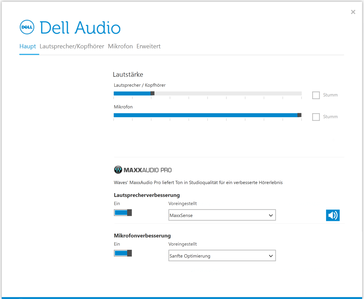
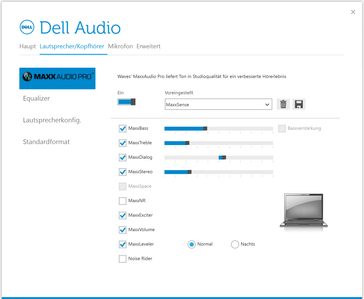
Energy Management
Power Consumption
Can you actually notice the improved efficiency of Skylake over Haswell in practice? If you ignore the slower Acer and look at the idle results, you will get just this impression, because the similarly powerful Haswell CPUs inside the Asus ZenBook and MSI PE60 consume much more power, even though a part of that additional consumption of the MSI is caused by the conventional HDD.
The powerful components are still noticeable under load, where the review unit consumes more than the rivals with Haswell quad-cores and (almost) the same GPU. We cannot really explain the difference. The higher resolution will hardly be the reason. The power adaptor is not powerful enough to cover the maximum consumption, so the battery is drained.
| Dell Inspiron 15 7559 GeForce GTX 960M, 6700HQ, SK hynix SC300 M.2 | Acer Aspire VN7-572G-72L0 GeForce GTX 950M, 6500U, Lite-On CV1-8B128 | Asus Zenbook Pro UX501JW-FI218H GeForce GTX 960M, 4720HQ, SanDisk SD7SN3Q128G1002 | MSI PE60-2QEi581 GeForce GTX 960M, 4210H, HGST Travelstar 7K1000 HTS721010A9E630 | |
|---|---|---|---|---|
| Power Consumption | 36% | -17% | -55% | |
| Idle Minimum * (Watt) | 9.4 | 5.2 45% | 15.6 -66% | 21.8 -132% |
| Idle Average * (Watt) | 14.4 | 9.4 35% | 20.5 -42% | 26.1 -81% |
| Idle Maximum * (Watt) | 15 | 10.8 28% | 21.2 -41% | 26.6 -77% |
| Load Average * (Watt) | 102 | 60 41% | 75.8 26% | 88.5 13% |
| Load Maximum * (Watt) | 120 | 80.9 33% | 72.9 39% | 119.7 -0% |
* ... smaller is better
| Off / Standby | |
| Idle | |
| Load |
|
Key:
min: | |
Battery Runtime
First, we have a look at the battery capacities of the four notebooks in this comparison. Dell Inspiron 15 7559: 74 Wh, Acer Aspire VN7-572G-72L0: 52.5 Wh, Asus ZenBook Pro UX501JW: 96 Wh (!), MSI PE60-2QWi581: 42 Wh. A direct comparison of the battery runtimes does not really make much sense when you consider these differences, but the results represent the different CPU-GPU combinations and capacities pretty well. The exception is the surprisingly bad result of the battery monster ZenBook Pro in the realistic Wi-Fi test (how we test).
| Battery runtime - WiFi v1.3 (sort by value) | |
| Dell Inspiron 15 7559 | |
| Acer Aspire VN7-572G-72L0 | |
| Asus Zenbook Pro UX501JW-FI218H | |
| MSI PE60-2QEi581 | |
Pros
Cons
Verdict
We have already mentioned that the pretty good initial impression of the rather expensive Dell Inspiron 15 7559 (RRP: 1299 Euros/~$1376) suffered a bit during our review. The touchpad, which is actually very good, revealed a build quality issue, and the very soft keyboard disappointed the author. The visually flawless chassis does look pretty great (matter of taste), but should have been sturdier. Optical drives might be less popular, but we expected one due to the size and the multimedia orientation. The touchpad driver is a bad joke, and the pulsating fan control can only be turned down with performance restrictions. The author also thinks the use of expensive touchscreens, which have a glossy surface, does not make a lot of sense for a non-convertible. Another question is whether you can really benefit from the high resolution on a 15-inch device or if there are only drawbacks like scaling issues and the high price.
Positive aspects include the good display with the wide viewing angles, high performance and the very maintenance-friendly construction, where you can actually access all important components including the fan by simply removing the maintenance hatch.
Many notebooks, including some gaming machines, should take this as a role model. The final rating is "just" 82%, so we cannot really recommend this notebook since the Acer Aspire VN7-572G-72L0 (85%) is, in our opinion, the more attractive package for the same price, despite the conventional, but matte Full HD display and just two GB of VRAM.
Dell Inspiron 15 7559
- 03/10/2016 v5 (old)
Sven Kloevekorn




